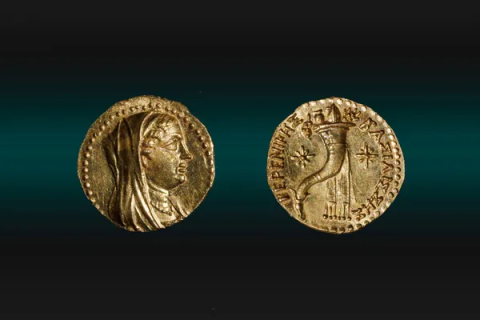Ancient Coin of Egypt's Queen Berenice Found in Jerusalem Excavations
According to the professional literature going back about a century, to date, about 20 coins showing Berenice, the wife of King Ptolemy III of Egypt, have been found, all in Egypt, says Robert Kool, head of the Numismatics Department at the IAA. None of the Berenice coins had been reported beyond the Nilotic kingdom until today, and none of the rest had been found in their correct archaeological context insofar as is known, say Kool and Dr. Haim Gitler, chief curator of archaeology and numismatics curator at the Israel Museum.
It was identified as a quarter-drachma. One side shows Berenice as a queen, with the requisite tiara and veil, and wearing a necklace. The reverse shows a cornucopia flanked by two stars with the Greek inscription "of Queen Berenice." It had been minted in about 240 B.C.E. during the reign of Berenice's husband, her cousin Ptolemy III Euergetes (246–222 B.C.E.).
It does bear mention that she wasn't the only female to appear on early Hellenistic coinage, but she was the only one to be coined "queen" on the currency. The coin bears a Greek inscription saying "basilisses," meaning "of the queen." But it cannot lend to the argument over whether or not she served as co-regent, Kool says.
This is the thing. Before marrying her cousin, Berenice had been a queen by her own right, ruling Cyrenecae, in Libya, from 258 to 246 B.C.E. The marriage united the adjacent kingdoms, but whether she co-ruled this expanded empire with Ptolemy III is not clear, and the gold coin – however precious – does not shed light on her status in Egypt, Kool says. He adds that a large 27-gram Ptolemaic gold coin showing Arsinoe doesn't mention her as queen.
(And if the coin showed a man? Usually, such coins say ruler of this or that, while others showing ladies merely mention a name, such as "Arsinoe," Kool explains.)
Coins were invented in the Greek world, and their usage reached Persia fast enough, but only reached Egypt from about 300 B.C.E., introduced by the Ptolemaic rulers. The pharaohs did not use currency, but barter, Kool explains: their traditional means of pay were grain, silver and gold – which they mined in Upper Egypt (today known as "Sudan").
That gold helped make the Ptolemy dynasties fabulously rich, Kool adds – "Ptolemy II's annual revenue came to about 400,000 kilograms of silver and about 162 million liters of grain."
The coin was probably minted in Alexandria and would not have been used as filthy lucre in trade, he surmises. The Hellenes reserved gold coinage for special occasions and foreign trade; major local deals were done in silver; and piddling payments were handled in bronze, the urban time-old method of bartering grain or intoxicating beverages. So although the Berenice coin is tiny, its value was not.
The biggest known gold coin weighed 27 grams of pure gold and was minted in Egypt during the Ptolemaic dynasty. Hence, the Berenice quarter-drachma is one of the smallest denominations, around 1 gram of gold, but what could it buy?
The monthly pay of a soldier was something like 2.5 silver drachmas, Kool says, and each drachma weighed 3.5 grams of silver. The Berenice coin, a mere "quarter drachma" would have been worth less than a soldier's monthly pay. He and the team surmise that the coin may have served as a reward to soldiers returning from the Third Syrian War, which pitted the two dominant Hellenistic powers at the time against each other: the Ptolemaic Kingdom of Egypt and the Seleucid Kingdom of Syria.
The coin was discovered by excavator Rivka Langler while sifting near the excavation area. She had been working at the site for two years, and this was her first find of gold, and of significance – "I saw other excavators discovering special finds, and I kept waiting for my moment – and now it finally arrived!" she told the IAA.
"The fact that such a rare gold coin was discovered in Jerusalem during the time when it was under Ptolemaic rule provides a fascinating glimpse into the city's status in those years and possible relations between the Jerusalem authorities and the Ptolemaic Empire," stated Yiftah Shalev, excavation director together with Efrat Bocher of the Center for the Study of Ancient Jerusalem.
After the destruction of the First Temple in 586 B.C.E., Jerusalem had been thought to have been weakened, he says – but this rare, valuable coin discovered practically in situ, and other discoveries, suggest it was rebounding.
Ruth Schuster

